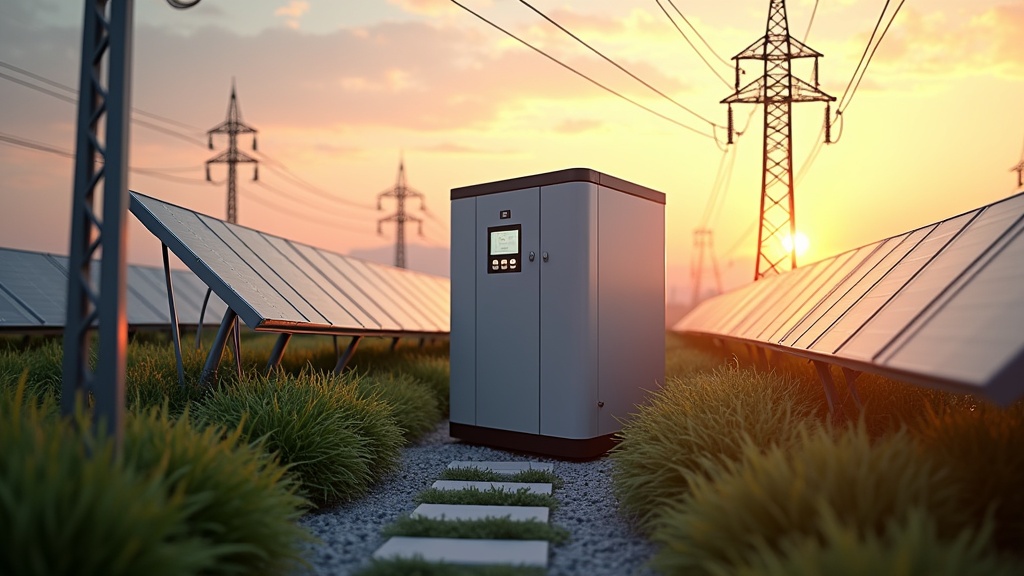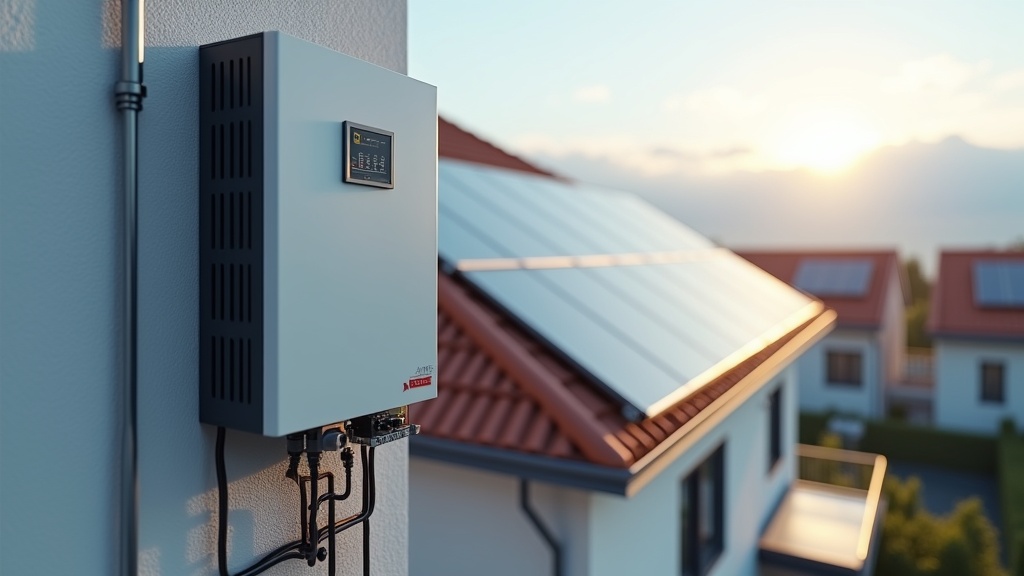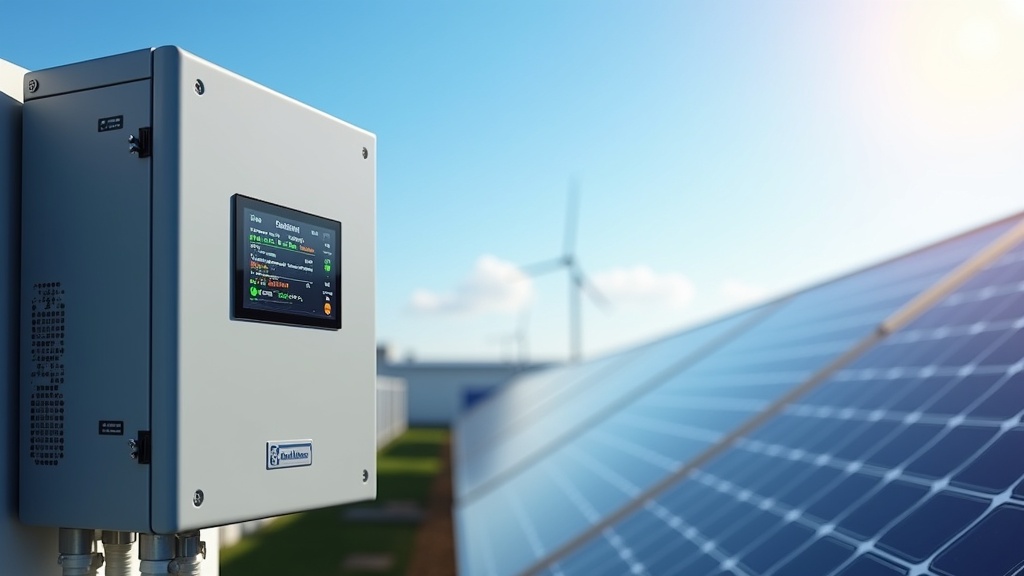
Have you ever wondered how solar inverters effortlessly weave solar energy into the fabric of your everyday life? At the core of any solar power system lies the solar inverter, a crucial component that performs the fundamental role of transforming the direct current (DC) generated by solar panels into usable alternating current (AC). Yet, these devices offer so much more than mere conversion. By utilizing Maximum Power Point Tracking (MPPT), inverters fine-tune power output to adapt to shifting conditions, ensuring optimal efficiency even in the presence of shadows or module degradation.
These advanced inverters possess the remarkable capability to communicate intelligently with the grid, deftly managing voltage and frequency to uphold grid stability and curtail fluctuations—a critical aspect for enhancing energy resilience.
But the enchantment doesn’t stop there; solar inverters meticulously supervise power output and the overall health of the system, relaying real-time data through Ethernet, Bluetooth, or Wi-Fi. This transformation simplifies energy tracking, empowering owners to make well-informed decisions. These inverters are not merely technological amenities; they are the unsung guardians of every solar installation, amplifying efficiency and elevating system performance.
Uncover how these versatile devices masterfully conduct solar systems, ensuring that you can capture the sun’s complete potential with each rising day.
| Function | Description |
|---|---|
| DC to AC Conversion | Transforms the direct current (DC) generated by solar panels into alternating current (AC) for household and grid use. |
| Maximum Power Point Tracking (MPPT) | Optimizes power output by adjusting voltage and current to the most efficient conditions. |
| Grid Stability | Manages voltage and frequency to maintain grid stability. |
| System Monitoring | Provides real-time data on power output and system health. |
| Protection Features | Includes protections against overvoltage, overcurrent, and overheating. |
Solar inverters convert AC to DC for solar panels.False
Solar inverters convert DC from panels to AC for use, not the reverse.
Solar inverters use MPPT to optimize power output.True
MPPT allows inverters to maximize efficiency by adapting to conditions.
What are the Core Functions of a Solar Inverter?

Have you ever paused to consider the pivotal role a solar inverter plays within a solar power system? More than just a technical apparatus, solar inverters act as the vital heartbeat of any solar installation. At their essence, these devices convert the direct current (DC) generated by solar panels into alternating current (AC), the preferred electricity form essential for virtually all household appliances and the electrical grid.
However, the capabilities of a solar inverter extend far beyond mere conversion. Leveraging the Maximum Power Point Tracking (MPPT) technology, these devices continuously fine-tune the energy output by adapting to the most favorable operational conditions. This is especially crucial in the face of challenges such as shading or the gradual decay of panel efficiency. Additionally, they maintain a seamless connection with the power grid, ensuring synchronization and stability as grid parameters undergo fluctuations.
Monitoring and reporting serve as vital features as well, enabling users to track power generation and swiftly identify any potential issues. The multifaceted responsibilities of a solar inverter—conversion, optimization, grid integration, and safety—render it an essential element in the efficient and secure transformation of solar energy into usable power.
Explore how this indispensable technology enhances energy yield and guarantees smooth operations of solar systems. Delve deeper into its intricate functionalities and empower your journey toward a sustainable energy future.
Understanding DC to AC Conversion
Transmuting direct current into alternating current is crucial within contemporary electrical frameworks. Delving into the arcane domain of power inverters necessitates an exploration of inverter ingenuity and the enigmatic art of electrical transmutation. The metamorphosis from DC to AC for domestic utilization augments efficacy remarkably. Alternating current generation unveils significant advantages, notably when coupled with renewable conduits such as solar inverters. Unleash the latent possibilities of AC power.
The Importance of DC to AC Conversion for Home Use
Harnessing the latent prowess of renewable energy hinges on adept DC to AC conversion. Inverter technology, essential in transmogrifying DC voltage into domestic AC electricity, takes center stage. By augmenting conversion efficacy, solar inverters meld effortlessly with home electronics, amplifying the advantages of DC to AC transformation for enduring energy solutions.
Challenges in Conversion Process
Venturing into the convoluted tapestry of conversion demands unwavering resolve amidst numerous impediments. Particularly within the virtual domain, conversion inefficiencies frequently hinder advancements. A meticulous analysis unveils prevalent blockade, deceleration in conversion. To surmount hurdles in sales conversion, devising innovative tactics is indispensable. Refine your conversion odyssey, obliterate obstacles, and master enigmatic funnel intricacies.
How Does a Solar Inverter Maximize Power Output?

Have you ever wondered how solar inverters could dramatically enhance the efficiency of your solar panel system? These devices are not just accessories; they play a crucial role in amplifying the power output by employing sophisticated strategies and cutting-edge technologies.
Central to this optimization is the Array-to-Inverter Ratio. This concept involves pairing a solar array with a capacity that exceeds that of the inverter itself, allowing for maximized energy production, even when the solar panels aren’t performing at their peak. But this is merely the tip of the iceberg!
Another revolutionary technology is Maximum Power Point Tracking (MPPT), which fine-tunes the voltage and current to ensure your system harvests the optimal amount of power, irrespective of fluctuating solar conditions. Picture this: during winter months, MPPT can potentially boost your power output by an astonishing 45%!
Then we have Regular Monitoring and Maintenance, an essential component that enables you to detect inefficiencies early on, helping to sustain your system’s peak performance. Coupled with the importance of proper sizing and the merit of Upgrading to Higher Efficiency Inverters, these practices are pivotal in realizing your system’s full potential.
Moreover, Smart Inverter Technologies can work wonders by optimizing energy production through dynamic power management. Last but not least, never underestimate the significance of avoiding shading and managing temperature—ensuring your panels remain unobstructed is vital for maintaining their efficiency.
Are you ready to unleash the full potential of your solar energy system? Delve deeper into these strategies, and transform your solar journey today!
| Strategy | Benefit |
|---|---|
| Array-to-Inverter Ratio | Maximizes energy production even during non-peak performance. |
| Maximum Power Point Tracking (MPPT) | Optimizes power output under varying conditions, boosts output by up to 45% in winter. |
| Regular Monitoring and Maintenance | Early detection of inefficiencies to maintain peak performance. |
| Smart Inverter Technologies | Enhances energy production through dynamic management. |
| Avoiding Shading and Managing Temperature | Prevents efficiency loss due to obstructions. |
Introduction to Maximum Power Point Tracking (MPPT)
Tap into the untapped potential of solar luminescence through Maximum Power Point Tracking (MPPT). This avant-garde innovation persistently fine-tunes photovoltaic arrays, magnifying their proficiency. Ingrained within solar systems, MPPT algorithms guarantee peak output. Discover MPPT’s prowess: superior energy seizing and harmonious grid amalgamation. Propel renewable ventures with state-of-the-art solar inverter technology.
Adjustments for Shading and Degradation
In the realm of architectural design, nuanced shading modifications wield tremendous influence in counteracting degradation phenomena. Through the deployment of sophisticated shading methodologies and scrupulous shading audits, optimization becomes tangible, diminishing environmental repercussions while amplifying shading efficacy. Meticulously crafted shading blueprints, aligned with degradation deterrence measures, present an all-encompassing vista of shading solutions.
Impact of MPPT on Energy Efficiency
In the realm of photovoltaic systems, Maximum Power Point Tracking (MPPT) astutely elevates energy conversion efficiency. This masterstroke of solar optimization, wielded by sophisticated algorithms, paves the way for sustainable energy paradigms. By honing power electronics and dc-dc converters, such efficiency enhancements in grid-tied mechanisms propel solar energy to greater echelons, heralding a new age of avant-garde energy systems.
How Do Smart Inverters Interact with the Grid?

Have you ever paused to consider how solar energy melds effortlessly with our existing power infrastructures? At the core of this fascinating integration is the solar inverter, and more specifically, the cutting-edge smart inverter. Moving beyond the simplistic role of traditional models, smart inverters function as sophisticated devices that embody autonomous decision-making capabilities and facilitate bi-directional communication. This technology significantly boosts the stability and reliability of our power grid by executing real-time coordination.
Smart inverters are crucial players in upholding both voltage and frequency stability within the grid; they have the remarkable ability to dynamically inject or absorb power as circumstances dictate. Furthermore, these innovative devices can mimic the inertia typically provided by conventional power generation methods, using synthetic and virtual inertia functionalities to counterbalance the diminishing inertia that arises from an increasing reliance on renewable energy sources.
An impressive feature of certain smart inverters is their “grid-forming” functionality. This allows renewable energy resources to engage proactively in regulating grid frequency and voltage, akin to the operations executed by traditional generators. As a standout takeaway encapsulates: “Smart inverters transition solar energy into usable electricity while fulfilling a vital role in stabilizing contemporary power grids through advanced grid support functions.”
With such transformative capabilities, smart inverters are redefining the integration of distributed energy resources (DERs), propelling our electricity grids toward greater intelligence and resilience. I invite you to delve deeper into the revolutionary influence of smart inverters within the landscape of modern energy solutions.
Bidirectional Communication with the Grid
In the realm of intelligent grid innovations, the symphony of bidirectional communication plays a cardinal role, augmenting grid dynamics via duplex communication architectures. Harnessing real-time data flux, energy governance systems elegantly meld with renewables, heralding peak energy optimization. The IoT’s metamorphic touch transforms distributed energy units, bolstering grid steadfastness. Cutting-edge metering frameworks propel power automation, nurturing a harmonious meshwork for seamless communication.
Voltage and Frequency Regulation
In the realm of electrical artisanship, astute voltage modulation and frequency calibration are paramount for the orchestration of power quality. Transmission conduit voltage oversight and load frequency governance are pivotal for the equilibrium of the power matrix. The advent of sustainable power progenitors demands avant-garde voltage stewardship stratagems. A profound grasp of voltage-frequency interplay augments automatic modulation methodologies in the symphony of frequency administration within power genesis.
Standby Modes for Grid Stability
In the realm of grid equilibrium, standby modalities are instrumental, sculpting energy orchestration and demand modulation paradigms. The steadfastness of crucial infrastructure is intertwined with the constancy of electrical networks, weaving renewable energy with finesse. Astute management of grids coupled with meticulous grid optimization fortifies resilience. Auxiliary power reserves, in tandem with standby mechanisms, amplify energy efficaciousness and equilibrium strategies.
What are the Monitoring and Protection Features of Inverters?

In the fast-paced landscape of renewable energy, grasping the operation of solar inverters is of paramount importance. What exactly does a solar inverter do? At its essence, it transforms the direct current (DC) that solar panels produce into alternating current (AC), rendering it suitable for your household devices. However, the inverter’s function transcends mere energy conversion; it integrates essential protective measures and monitoring capabilities that enhance system durability and dependability.
Among its primary safeguarding features are protections against overvoltage, overcurrent, and overheating, which interrupt functionality to avert potential damage to components during extreme conditions. Additionally, short-circuit, undervoltage, and surge protections serve as critical defenses against unpredictable electrical irregularities. It’s imperative to highlight that: “Solar inverters not only convert energy but also incorporate comprehensive protection and monitoring systems to ensure smooth and secure operation.”
Moreover, these inverters provide real-time monitoring of vital parameters and safeguards such as anti-islanding and polarity protection, ensuring safe interaction with the grid and maintaining system integrity. Delve deeper into the multifaceted role of solar inverters—not only do they energize your home, but they also fortify it—by exploring the advanced technology that underpins these remarkable innovations.
Real-Time System Monitoring Options
Charting the labyrinthine realms of real-time system oversight necessitates advanced instrumentation. Employ server surveillance technologies, encompassing both application and network scrutiny, to render IT infrastructure more navigable. Harness the potential of cloud surveillance for holistic governance, facilitating anticipatory monitoring. Real-time notifications coupled with in-depth data examination bolster performance management across varied IoT landscapes.
Fault Detection and Troubleshooting
Within the domain of industrial malfunction identification, automated detection mechanisms significantly elevate productivity. Integrating fault discernment algorithms alongside machine learning augments foresighted diagnostic proficiency. The utilization of fault analysis methodologies and diagnostic software facilitates exact electrical malfunction rectification. Real-time detection instruments transform fault governance by leveraging sophisticated predictive maintenance and foundational cause dissection.
Ensuring Safety through Voltage Parameter Control
Mastery over voltage paradigms plays a quintessential role in safeguarding electrical frameworks. Sophisticated voltage modulation methodologies, harmonized with stringent safety protocols, empower formidable energy stewardship. Emphasizing regulation safety and vigilant oversight, we attain optimal voltage thresholds. Proficient risk stratagem fortifies voltage equilibrium, preempting hazards, thereby cementing an impenetrable bastion of comprehensive system safety.
How Can Inverters Facilitate Power Production Tracking?

Have you ever paused to consider the crucial role a solar inverter plays in harnessing sunlight? Beyond serving as a mere conduit that transforms direct current (DC) into alternating current (AC), it emerges as a vital linchpin in enhancing the efficacy of solar energy generation. These inverters are laden with cutting-edge capabilities, such as real-time data acquisition and performance monitoring, which empower users to effortlessly track their solar system’s operational status through integrated sensors and advanced communication protocols. Protocols like Modbus or SunSpec are integral, enabling comprehensive remote system oversight and diagnostics, thus ensuring you maintain complete control over your energy generation.
Equipped with Maximum Power Point Tracking (MPPT) technology, solar inverters optimize energy yield by ensuring that your solar panels consistently function at their peak capacity, regardless of fluctuating environmental conditions. Serving as the central command for performance oversight, inverters amass crucial information regarding energy production and potential anomalies, providing prompt resolutions to maintain optimal efficiency. The latest models further enhance user experience by incorporating remote management features, enabling you to access system analytics and receive notifications via user-friendly software platforms or mobile applications.
For those well-versed in solar technology, such functionalities represent the pinnacle of energy optimization. With the ability to monitor each component independently and generate detailed performance reports, these inverters deliver invaluable insights poised to boost system efficiency. Capitalize on these features to elevate both the performance and dependability of your solar energy system, ensuring you harness every ray of sunlight with confidence and prowess.
Tracking Energy Output Using Smart Devices
In the contemporary epoch, the metamorphosis of efficiency driven by smart energy-tracking contraptions is undeniable. With the deployment of intelligent energy meters, meticulous tracking of energy output is achieved, allowing for instantaneous oversight. These IoT-centric tools bestow upon energy management systems the prowess to optimize consumption, elevating smart home efficiency. This sustainable energy vigilance cultivates eco-centric lifestyles.
Communication Capabilities for System Monitoring
Within the intricate domain of system surveillance, the primacy of communication faculties cannot be overstated. Crafting potent communicative schemas catalyzes real-time oversight and advances performance dialogues of systems. By utilizing cutting-edge surveillance apparatus and protocols, proactive, automated vigilance over system vitality is attainable. Adopting exemplary practices in network communication auditing can significantly propel enterprise IT exchanges to newfound zeniths.
Advantages of Real-Time Performance Data
Integrating instantaneous performance metrics revolutionizes enterprise functionality. The benefits are multifaceted, delivering immediate boons. Real-time oversight propels strategic enhancements, while live tracking empowers informed decision-making. Adopting these analytics yields actionable intelligence, refining efficiency and securing unparalleled business acumen.
Conclusion
In summary, solar inverters serve as a pivotal component in optimizing solar energy systems. Their ability to convert DC to AC power, alongside advanced features such as MPPT, grid interaction, and comprehensive monitoring capabilities, enhance both energy efficiency and grid stability. Smart inverters, in particular, revolutionize energy systems through dynamic communication and adaptive management. These functional traits collectively ensure that solar installations not only meet current energy needs but are also equipped to handle future advancements. By leveraging these technologies, users can maximize energy harvest, ensure system reliability, and actively contribute to a sustainable energy landscape. Embracing the capabilities of modern solar inverters can be the key to unlocking your solar potential and achieving greater energy independence.


